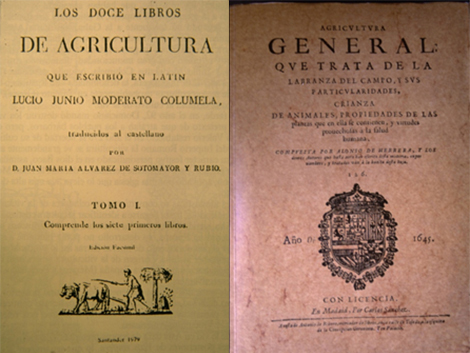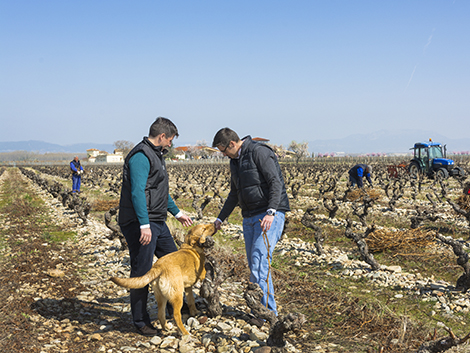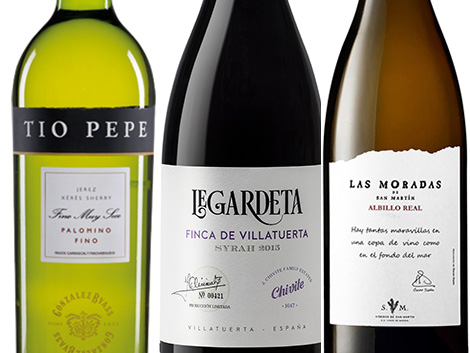
Be it natural genetics or man-made interspecific hybrids, disease-resistant grape varieties will become a priority in the future.
In the Iberian Peninsula climate change (higher temperatures, lower rainfall, less incidence of frost and increasing hail and fog episodes in areas of coastal influence) has resulted in grapes that ripen faster with more alcohol. Nowadays wines are warmer and have lower acidity. Another worring consequence is the growing impact of pests and diseases.
The figures speak for themselves. Vineyards hardly account for 3% of the world's cultivated land, but receive 20% of the global fungal treatments.
If we view this figures in a context where sustainaibility, lower production costs and health issues are increasingly important, the growth of organic grape growing, biodynamics, fungi-resistant grape varieties and the avoidance of fungicides are logical steps.
Charting the history of vine diseases provides a better understanding of their impact on the wines we are currently drinking.
From Columela to Alonso de Herrera
In the 2nd century AD, Columela recommended to discard cuttings and wooden sticks used as rudimentary trellises once the soil was dry in order to avoid diseases and to have a solid ground. From his writings we can deduct that trunk diseases, mainly eutypa and esca, were the most worrying threats of his time. Mildew and powdery mildew, which were brought from North America in the 19th centrury, didn’t exist in Roman Hispania.
Unfortunately trunk diseases are back to stay. Romans prevented esca by pruning late during the bleeding stage and avoided lacerations which are much more frequent if prunning is done during the winter dormancy period when shoots are particularly dry. They also used to remove all the shoots from the vineyards. But nowadays, most vineyards are trellised and pruned vine shoots are often crushed to feed the soil, thus favouring the spread of trunk diseases. The regular use of vine shoot tipping machines during the dormant periodo results in a high number of lacerations.
In 1513, Alonso de Herrera recommended to apply on the vines a blend of urine, vinegar and ashes before budding. Who knows, perhaps this unusual concoction which was said to fight trunk diseases could hide some sort of reemdy to this worring threat. Herrera also mentioned aphids and other “vermins” which were common in low, humid valley areas. Nowadays, the main insects in vines are trips, green mosquitos, pyralid moths, grapevine moths and aphids together with the phylloxera which was first spotted in Spain in the province of Málaga in 1878. It is highly likely that aphids were a bigger threat in the 15th and 16th centuries; today they only attack certain types of table grapes.
The American pests
The 19th century brought two devastating pests to Europe's vineyards: downey mildew and powdery mildew. They were hidden in plants imported from North America destined to the gardens of France and England. American vines had developed a natural resistance to them, but this wasn’t the case with Vitis Vinifera. This explains the dramatic drop of wine production until effective remedies to combat these diseases were found.
Powdery mildew spread throughout the Iberian Peninsula between 1851 and 1862. Conditions for its developement include average humidity and temperatures ranging from 15° and 35° C, optimally between 25° and 28° C. It is inhibited by generous rainfall, high humidity or temperatures exceeding 40° C. It was not until 1863 that a solution was found in France to stop it: plants were sprayed with sulphur using machinery developed in Bordeaux and Montpellier.
Downy mildew appeared in Europe in 1878 on American rootstocks imported as grafting stock for Vitis Vinifera to combat phylloxera. Downy mildew develops on vine shoots longer than 10 cm when average temperature are above 12° C and one to two days of rain (10 l/m2). Once this preliminary attack occurs, a bit of rain or having wet leaves for more than two hours can cause a secondary attack that damages the vine leaves and bunches. In 1885 French scientist Alexis Millardet found a way to combat it when he invented the Bordeaux mixture which is a mixture of copper sulphate and quicklime. This remedy, which can easily be made at home, is widely used in organic viticulture by mixing copper sulphate and calcium hydroxide.
The development of fungus-resistant grapes
At a congress on vine rootstocks held in Montpellier in 1911, French vine-breeder Georges Couderc said: “Phylloxera was defeated by the use of American rootstocks, not by carbon sulphide; chlorosis by lime resistant rootstocks, not by iron sulphate; peronospora will be defeated, in the short or long term, by hybrid, fungis-resistant varieties, not by copper.”
For many years, countries with a long-standing winemaking tradition have relied on clonal selection to improve their vines. However, with global warming this is proving increasingly ineffective as diseases are increasingly more challenging. Moreover, clones are very similar to each other and do not meet the current needs of many producers. The interspecific hybrids suggested by Couderc 100 years ago had several major drawbacks: they generated methyl alcohol, tasted foxy and their sensory features were not those found on quality grape varieties. But this is changing now.
The first fungis-resistanf hybrids were created by Louis and Henri Bouschet by crossing American and European viniferas. Even if their most famous achievement was Alicante Bouschet, a red-fleshed grape usually called Garnacha Tintorera in Spain, they also produced the Delaware and Catawba hybrids, which were phylloxera-resistant but were not resistant to downy mildew and powdery mildew. Yet systematic hybridization was carried out in France between 1870 and 1920. Some of the hybrids created during this period include Noah, Clinton, Bacò, Marechal Foch and Seyve Villard, among others.
The creation of interspecific hybrids between the European Vitis Vinifera and American species slowed down until the 1980s when several wine research institutes in France, Germany, Austria, Czechoslovakia, Hungary and Italy began to develop new hybrids with improved agronomic features and, most importantly, positive oenological qualities (fruity aromas, high anthocyanin content…) thus the Regent GER, Roesler AUT, Waxmann CHE or Bianca HUM were born.
The current state of fungi-resistant hybrids
In 2007, the hybrids Regent, Prior, Johanniter, Cabernet Cortisa and Solaris were authorised in Germany, Austria and Switzerland. Italy registered the Bronner and Regent varieties in its National Catalogue in 2009 and the Cabernet Cortis, Cabernet Carbon, Helios, Johanniter, Prior and Solaris in 2013. Hybrids Regent, Bronner, Solaris and Cabernet were approved in the DOC Trentino-Alto Adige in 2014 as highly suitable varieties to be grown in rainy areas prone to mildew and powdery mildew.
An association supporting the exchange of information between research institutes, grape growers and wine producers, PIWI fosters the expansión of fungi-resistant grape varieties. Its area of influence inlcudes northern Switzerland and the Valais region in the south, the Trentino- Alto Adige in Italy, Germany, France and Austria.
France has a second line of research based on hybrids created between 1974 and 2009 by Alain Bouquet at Montpellier’s INRA (National Institute for Agricultural Research) as backcrossings of Vitis Vinifera and Muscadinia Rotundifolia. Muscadinia was chosen for its high resistance to downy mildew and powery mildew. We now know that this resistance lies on chromosome 12, but Bouquet did not employ amodern molecular genetics; he just used the agronomic knowledge of the plant material in Montpellier’s vine collection. The INRA is developing four projects based on Bouquets’s work. Two worth highlighting are the VitiDurable programme aimed at producing wines with different profiles and further research to make quality wines with low alcohol content.
In Italy, several universities and nurseries are working on back crossings of disease-resistant grapes with well-known international varieties like Cabernet Sauvignon, Merlot, Pinot Noir, Muscat, Nebbiolo or Sangiovese.
In Spain, Swiss grape geneticist Valentin Blattner is carrying out similar tests at Albet i Noya in Penedès since 2013 using Xarel.lo, Macabeo and Parellada. They have obtained over 30.000 seeds and 1.000 plants are already being assesed. In southeast Spain, the IMIDA (Murcia Institute for Agricultural and Food Research and Develpment) is focusing on Monastrell.
Tradition vs. competitiviness and environmental sustainability
The main goal of hybrids is to allow wine growing in extreme locations while avoiding the use of phytosanitary products and obtaining competitive and healthy wines. But such expansion will bring major changes in viticulture as we understand it today as it will get closer to horticulture and fruit farming. Here varieties are replaced every five or six years by new ones with higher quality or better suited to market demands, climate change or new diseases. This puts at risk wine's cultural dimensión and its link to history, terroir, indigenous grapes and traditional local wines.
Planting traditional grape varieties that are less sensitive to mildew and powdery mildew could avoid this situations, but traditional varieties would never be as resistant as interspecific hybrids obtained from American species.
Grape growing in Europe and Spain is set to embark on a debate about the use of highly competitive grapes resulting from interspecific crossings that hardly require any phytosanitary products and the preservation of traditional, indigenous varieties. Is there enough genetic diversity (even if in many cases this is still unknown) to prevent the introduction of interspecific hybrids or should we focus on both simultaneously?
Below is a list of how resistant are some od Spain's main grape varieties to downy mildew and powdery mildew of Spain’s main grape varieties. The winners are far from being among the most popular or widely planted. The top performers include deep-coloured, low-yielded red varieties from the north of Spain with high levels of acidity like Carrasquín, Pedrol and Hondarrabi Beltza, aromatic white grapes such as Galicia’s Loureiro, and white and red Mediterranean varieties boasting higher acidity than their local counterparts: Pampolat Girat, Quigat and Parellada.
RESISTANCE TO MILDEW AND POWDERY MILDEW OF SPAIN'S GRAPE VARIETIES
Highly prone to powdery mildew and mildew: Tempranillo, Garnacha Tinta, Cayetana Blanca and Cabernet Sauvignon.
Moderately prone to powdery mildew and highly prone to mildew: Airén, Palomino Fino and Bobal.
Moderately prone to powdery mildew and mildew: Verdejo and Pedro Ximénez.
Little prone to powdery mildew; moderately prone to mildew: Monastrell.
Little prone to powdery mildew: Albillo Real, Blanquiliña, Carrasquín, Cuatendrá, Doradilla, Eperó de Gall, Fogoneu, Forcallat Tinto, Gorgollasa, Legiruela, Listán Prieto, Loureira, Malvasía Volcánica, Garro, Mansés de Tibbus, Manto Negro, Mondragón, Morrastel-Bouschet, Ondarrabi Beltza, Pampolat de Sagunto, Pampolat Girat, Parduca, Parellada, Pedral, Perruno, Petit Bouschet, Quigat, Sabaté, Santa Magdalena, Señá, Trobat, Verués de Huarte and Vinaté.
Little prone to mildew: Batista, Caiño Tinto, Carrasquín, Folle Blanch/Ondarrabi Zuri, Loureiro Blanco, Maturana Blanca, Merseguera, Ondarrabi Beltza, Pampolat Girat, Parellada and Sousón.
Little prone to powdery mildew and mildew: Carrasquín, Loureira, Hondarrabi Beltza, Pampolat Girat, Parellada, Quigat and Pedrol.

Félix Cabello
An agricultural engineer with a PhD from the Polytechnic University of Madrid, he was head of the Agricultural Food Department at the Institute of Agriculture and Food Research in Madrid and the El Encín Vine Collection
15 smart buys to enjoy throughout 2020
NEWSLETTER
Join our community of Spanish wine lovers






